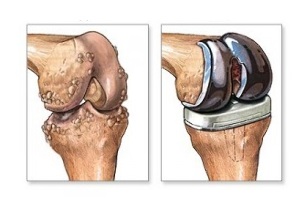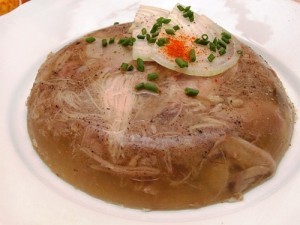When walking or running, our knee joints are under constant stress and tension, often causing pain. The most common topic of referral to healthcare professionals is knee pain. The standard diagnosis after a physical examination is the initial stage of osteoarthritis of the knee joint. How to determine the cause of pain and what should be done to eliminate it?
Unfortunately, it is impossible to answer completely unambiguously these questions that concern almost everyone. Knee joint problems are so varied and the reasons for their occurrence are so many that one should not rush to jump to conclusions.
Today we will talk about the most common of these reasons, the consequence of which is a pathology such as the initial stage of osteoarthritis. In addition to this, we will explain your symptoms, as well as the prevention and treatment methods.
The main cause of osteoarthritis of the knee joint

There is another medical term for a joint injury of this type without an inflammatory process: gonarthrosis. It is gonarthrosis that can subsequently lead to the deformation and destruction of the cartilage of the joints, which leads to a pain syndrome and limits its mobility.
The cause of osteoarthritis of the knee joint, or gonarthrosis, can be divided into 2 stages:
- initial, that is, one that arose as a result of existing joint pathology; Secondary
- , that is, one that has arisen as a result of acquired injuries or infections.
Let's stop at stage 1. This early form of pathology is quite common and can manifest itself from a very young age. It is not caused by the natural formation of the superficial tissue of the joints or the ligamentous apparatus of a person. It is quite natural that when walking, the degenerative joint is disproportionately loaded, this causes pain and destructive consequences.
Stage 2 includes all injuries and mechanical effects of varying severity of damage to health. These can be bruises, fractures, sprains, and dislocations of the knee joint. The consequences of surgery are possible, which invariably leads to the destruction of the integrity of the knee. A high degree of sports loads, excessive obesity that does not correspond to the proportions of the body - all these are factors that provoke the initial stages of knee osteoarthritis.
By the way, excessive weight not only provokes the disease, but also creates an unfavorable background that contributes to the formation of excessive pressure in the knees on the articular cartilage and completely disrupts the metabolism.
At the same time, fluid accumulates in the knee joint cavities, leading to further complications, which also turn into the stage of osteoarthritis. We add here any previous operations on the legs or diseases accompanied by prolonged spasms of the blood vessels or leg muscles - deformation is inevitable!
Usually, unilateral knee osteoarthritis develops due to traumatic effects to the knees or hip joint. If this is the effect of excess weight, then it is bilateral.
The main signs of osteoarthritis of the knee joint
This process does not happen instantly. Usually, for a long time, at first, a person feels slight discomfort in the knee joint area, and only after years these sensations turn into severe pain. People over 40 years old, who are overweight and have additional loads in the form of varicose veins, are prone to the initial stage of osteoarthritis of the knee joint much earlier.
Let's look at the traditional sequence of stages of this disease:
- Long or leading. A period of one to several years is common. From time to time, not too acute pains are observed in moments of tension in the knees.
- Second stage or critical stage. Here there is already a noticeable characteristic crunch of any sudden movement of the knee joint. The volume of its motor activity decreases, and an increase in the knee is visually determined, indicating its deformation and the possible accumulation of fluid in the joint cavity.
- The last stage of osteoarthritis of the knee joint will consequently be characterized by an acute painful condition of the knee joint even at rest. At this time, the stage of osteoarthritis becomes chronic, a person reacts painfully to any meteorological phenomenon, and his gait acquires a specific "duck" movement, "waddle". In this case, the patient's legs at this stage are bent.
In the case of osteoarthritis of the knee joint due to injury, all these stages listed above begin to pass even faster.
Prevention and treatment of the initial stage of knee osteoarthritis
It must be taken into account that absolutely all therapeutic measures will depend entirely on the degree of damage to the knee. At the same time, the effectiveness of treatment can only be achieved if the cause of arthrosis is eliminated. If this process is in an early stage of formation, then a complete cure is possible! With a chronically advanced process, initially it is possible to achieve only a more or less prolonged phase of rest of the diseased organ.
To restore deformed cartilage, strengthen ligaments and increase motor activity in the joint, it is necessary to undergo complex therapy. This includes not only medications, but also manual massages, physical therapy procedures, and, if absolutely necessary, surgery.
The selection of drugs should in no case be independent, since self-medication for such a complex disease has serious consequences. The main focus of drug treatment is to eliminate pain, localize the inflammatory process and neutralize the stage of osteoarthritis. For this purpose, special preparations can be prescribed for their introduction into the cavity of the knee joint. The appointment of hormonal drugs is not excluded.
For active blood circulation in the affected area, means are used to relieve vascular spasms and relax muscles. In addition, preparations are prescribed for the replenishment of vitamins and the restoration of cartilage tissue.
The complex of preventive measures and for the treatment of the initial stage of knee osteoarthritis should include a relaxing manual massage. With its help, an increase in the volume of movement, the elimination of spasm and an increase in blood circulation is achieved, the position of the joints and bones, including the hip bones, is corrected.

If the initial stage has long developed into irreversible damage to the knee joint, in this case, a radical correction of the deformed organ is performed, that is, implantation (prosthesis). Today there is and is actively used only one way to replace a destroyed joint - to install a metal endoprosthesis. Such an implantation is by no means durable and its cost is so high that there is no need to talk about the massive application of this method.
Important!If you still decide to go to the operating table, keep in mind that knee replacement and rehabilitation are interrelated. You will have to work hard to recover to a good level.
The treatment of the initial stage of osteoarthritis also includes a complex of rehabilitation therapy, which includes absolutely the entire spectrum of spa treatments, from physiotherapy and physiotherapy exercises to kinesitherapy. The concept of kinesitherapy includes specially designed exercises using loads of varying degrees of gravity and medical simulators.
If necessary, it is recommended to reduce the pressure on the knee with canes, crutches or orthoses, the so-called knee braces that soften the load during movement. A large number of simple and complex recipes of traditional medicine are successfully used in the treatment of any stage of arthrosis.
It can be various compresses and ointments based on natural ingredients, from animal hair and medical bile to herbal preparations. In general, the prescription of traditional medicine recipes is quite effective, as it aims to eliminate the symptoms of knee joint disease and eliminate painful sensations.
Additional prevention methods
First of all, it is a complete and balanced diet. The diet, in addition to proteins and carbohydrates, must include the optimal content of vitamins and microelements. At the same time, it is strongly recommended that you avoid bad habits and try to get your weight back to normal.
The general nutritional guidelines to prevent osteoarthritis are as follows:

- avoiding red meat;
- refusal of high-fat foods;
- the use of jellied meat and similar dishes that contain cartilage and a gelatinous substance as part of your recipe;
- increase in the consumption of pure spring water up to 2. 5 liters or more;
- total rejection of alcoholic beverages and regular consumption of vitamins A, D and B.
It is highly recommended to check your wardrobe to exclude uncomfortable shoes, for example, high heels or one-sided worn. Watch your postures to avoid crossing or interlocking your legs in a sitting position. Protect your joints from prolonged chilling and also from hypothermia. Avoid stressful situations and don't be nervous about trifles.
Try to lead a healthy lifestyle in which the body is in good shape. In addition, such physical activity is extremely important, which would correspond to the state of the knees and the hip joint. It is for this reason that self-control and extra caution is necessary when playing sports, before lifting weights or intensively performing certain exercises.
The most important preventive condition after knowing the initial stage of the disease is to avoid its further development, since if the process starts, it can lead to disability. In the case of timely detection of osteoarthritis and preventive measures to prevent it, the probability of a complete cure is high.
Be sure to consult your doctor before treating illnesses. This will help to take individual tolerance into account, confirm the diagnosis, make sure treatment is correct, and exclude negative drug interactions. If you use prescriptions without consulting a doctor, then it is at your own risk. All information is presented for informational purposes only and does not constitute medical aid.





































